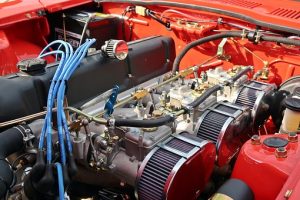 Regular maintenance is key to keeping your car healthy, optimizing its performance capabilities, and making it last for many years. The schedule you should follow depends on your vehicle, your driving habits, and the weather and road conditions where you drive. Nissan offers two different maintenance schedules. Schedule one is for those who drive in severe conditions, and schedule two is for less severe conditions. Here are some of the important maintenance milestones for Nissans, so you know when to bring it into the dealership for service.
Regular maintenance is key to keeping your car healthy, optimizing its performance capabilities, and making it last for many years. The schedule you should follow depends on your vehicle, your driving habits, and the weather and road conditions where you drive. Nissan offers two different maintenance schedules. Schedule one is for those who drive in severe conditions, and schedule two is for less severe conditions. Here are some of the important maintenance milestones for Nissans, so you know when to bring it into the dealership for service.
1. 3,750 Miles or Three Months
When your vehicle hits three months or 3,750 miles and you follow the schedule one maintenance, you should bring it in for an oil and filter change. If you follow the schedule two guidelines, you can wait another few months unless you drive a Titan FFV or an Armada FFV. You should bring those in for an oil and filter change.
2. 7,500 Miles or Six Months
At 7,500 miles or six months, those following schedule one should have the oil and filter changed again. Nissan service center technicians will rotate the tires and inspect the axle and suspension. They will also check the brake pads, drive shaft boots, exhaust system, and steering system, including the gear, linkage, and linkage ball joints. If you follow the schedule two maintenance, during your first oil and filter change you should also have the tires rotated.
3. 11,250 Miles or Nine Months
After you drive the car for nine months or you hit 11,250 miles, when following the schedule one maintenance, bring your car back in for an oil and filter change. Schedule two followers can wait another three months or 3,000 miles.
4. 15,000 Miles or 12 Months
When you hit the one year mark, or your car has 15,000 miles on it, you should bring it back to the dealership for maintenance if following schedule one. At this time, technicians will change the oil and filter and replace the in-cabin microfilter. They will also inspect the transmission fluid and the eCVT fluid, along with the axle and suspension. The technicians will also inspect the brake parts, cruise control vacuum hoses, drive shaft boots, exhaust, and the all the steering components. If you follow the schedule two maintenance, they will perform the same inspections as the schedule one six-month items.
5. 30,000 Miles or 24 Months
Another big inspection time is when your vehicle reaches 30,000 miles or 24 months. At this point, both the schedule one and schedule two maintenance checks include a look at all the things in the one-year check. In addition, technicians will test fluids in the CVT, differential oil, and all the fuel lines and fuel tank hoses.
Make sure to keep up with the maintenance and stay on schedule to ensure your vehicle runs properly. If you don’t properly maintain your car, you can also risk voiding the warranty. It’s well worth staying on top of maintenance for both your wallet and your peace of mind.
Image from Pixabay licensed under CC BY 2.0


![[Facebook]](https://www.scottclarknissan.com/blogs/1043/wp-content/plugins/bookmarkify/facebook.png)
![[LinkedIn]](https://www.scottclarknissan.com/blogs/1043/wp-content/plugins/bookmarkify/linkedin.png)
![[Twitter]](https://www.scottclarknissan.com/blogs/1043/wp-content/plugins/bookmarkify/twitter.png)
![[Yahoo!]](https://www.scottclarknissan.com/blogs/1043/wp-content/plugins/bookmarkify/yahoo.png)
![[Email]](https://www.scottclarknissan.com/blogs/1043/wp-content/plugins/bookmarkify/email.png)


